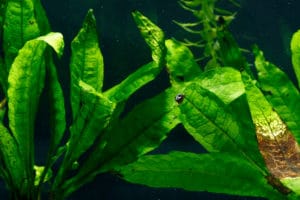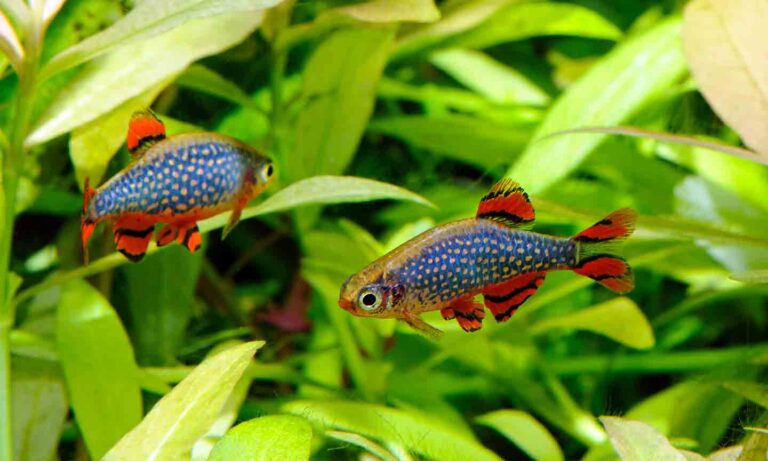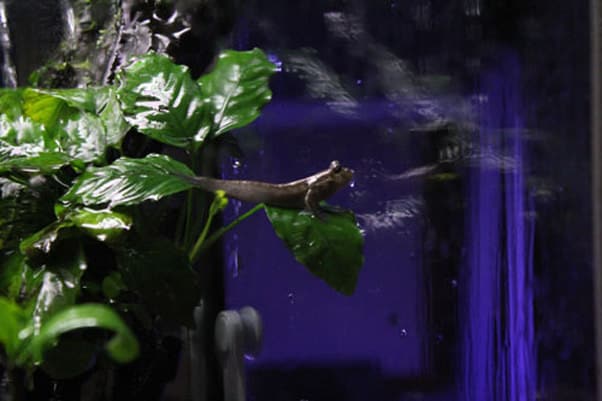As the monster fish movement continues to grow, more and more bizarre, brutish freshwater fish species have been grabbing attention. One such species that has recently gotten some notice is the truly gluttonous gulper (or torpedo) catfish (Asterophysus batrachus Kner, 1858). It is a member of the family Auchenipteridae (the “driftwood catfishes”) and is the sole species of its genus. There really are not a lot of catfish (or any fish) out there that are anything quite like it. With its unscaled (or “naked”), bulbous body, gaping mouth and beady eyes, it looks more like something from the deep sea than from a forest stream.
The gulper cat hails from the slow-moving tropical blackwaters of northern South America (principally the Negro and Orinoco river basins in Brazil and Venezuela). Its habitat is characterized by an abundance of submerged woody debris. This nocturnal, bottom-dwelling carnivore spends much of its daytime hiding in the shade of sunken logs; it emerges from hiding at night to hunt mainly for other fish.
The gulper catfish is specially adapted to consume comparatively large prey items. The jaws of its huge mouth extend to the back side of its head. The skin of its belly can stretch to accommodate especially large meals. Most agree that gulpers can easily eat fish half their size; some claim they can eat fish twice their size. It should be noted that the catfish can be injured or even killed if it attempts to swallow more than it can handle.
By most accounts, the gulper catfish poses no particular challenges in captivity, so long as it is kept with tankmates of an appropriate size. Most suggest housing this fish with others that are at least similar in size, if not significantly larger. It is easy to underestimate the predatory drive and capability of this specialized piscivore. In the small confines of an aquarium, if there is any chance of predation occurring, it likely will. Gulper catfish tend to wander as they forage, so they are best not kept with highly aggressive, territorial species. Be aware also that their nighttime activity can startle easily-spooked fish like arowanas.
Generally, gulpers are like typical captive catfishes in that they need little coaxing to accept prepared fish food. Nutritious, whole frozen items such as silversides and shrimp are ideal for this purpose. Some keepers enjoy hand feeding their gulper cats. While it might be especially tempting to elicit this animal’s predatory feeding behavior by offering it live feeder fish, the practice should only be considered by those with a source of disease-free feeders and a high-quality gut- loading food. If live feed must be used (in the most rare of cases) to get a fussy specimen to start eating, feeders should be preemptively treated for parasites and quarantined for at least 30 days prior to use. Feeders should be gut-loaded immediately prior to use.
More than anything, the gulper catfish aquarium should be big. Most who are familiar with the species recommend tank sizes of 100 gallons or more. Not only does the fish typically reach a respectable size of about 10 inches, it is said to attain lengths of 12 or 14 inches in some cases. And, their tankmates–each and every one of them–must be just as big or bigger. So, the big fish aquarium will need a big fish tank filter to match.
Just as the gulper should have a cave or overhang of its own to retreat from strong light during the day, it should have a large, open space on the bottom to swim over and forage on at night. Substrates and stones should be soft as to not irritate the animal’s soft, scaleless skin. For this, sand and smooth, river-worn rock work well. Woods should certainly be included in the aquascape. For this, use soft, chunky, waterlogged pieces rather than hard, sharp, branchy pieces.
Like most large, predatory fish with big appetites, the gulper catfish is a messy eater that can produce a lot of waste. Large and frequent water changes, therefore, are essential. It is helpful to have a siphon tube of some sort on hand to remove the fish’s solid wastes wherever they accumulate on the bottom. Water quality should be reasonably good, with a pH around 6.3 and a water temperature of 75-84°F.
With appropriate tankmates and plenty of living space, the gulper catfish can rather easily be maintained in captive conditions, where they add an odd kind of charm to the aquarium. Finding one, however, can be a challenge. They are uncommon in the wild and are only infrequently exported. Their scarcity, combined with their exquisitely grotesque appearance, makes for an unusually expensive freshwater ornamental fish. Judging from its growing popularity, this catfish is worth every bit of the time, effort and dollars. Just look at that face!
Posted by: Chewy Editorial
Featured Image: Dan Olsen/Shutterstock.com
Share:










